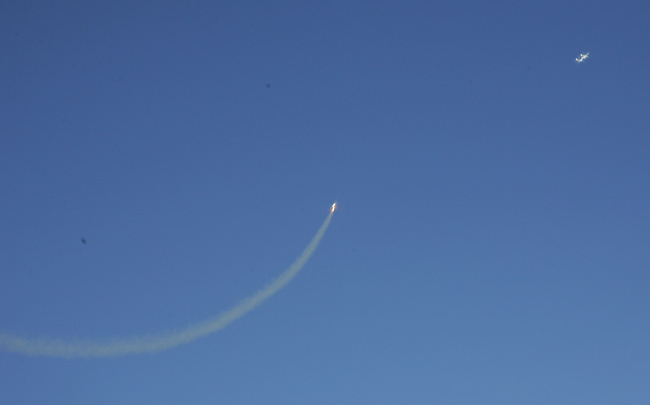Suborbital Dreams: One Year After SpaceShipOne's Historic Flight

The futurelooks bright for civilian suborbital spaceflight, with a host of private firmsdeveloping spacecraft to carry anyone with a willing heart and a robust bankaccount on the ultimate trip.
One yearafter the history-making suborbital space shot of SpaceShipOne, commercialspaceflight efforts continue to make headway through government regulation andtechnological hurdles, each with its eye on the space tourism market.
On June 21,2004, the privately-built SpaceShipOnedropped from its White Knight mothership above the Mojave Desert and rocketedinto history as the first civilian-funded spacecraft to reach suborbital spacewith a human pilot at the helm.
Built byaerospace veteran Burt Rutan and his Scaled Composites firm, SpaceShipOne wenton to make two more suborbital flights within two weeks between September andOctober 2004. The final two flights clinched the Ansari XPrize, a $10 million challenge, for SpaceShipOne's MojaveAerospace Ventures company backed by entrepreneur and billionaire Paul G.Allen.
Virginchief Sir Richard Branson's VirginGalactic, a tourism firm licensing SpaceShipOne's technology for commercialsuborbital flights, hopes to have a final design of its five-seater spacecraftby year's end.
"I'm stillconfident we will get there this year," Virgin Galactic president WillWhitehorn told SPACE.com. "Suborbital space tourism will prove thatgovernments don't need to stand behind us in order to reach space."
Meanwhile,at least two firms, Canada's CanadianArrow and New Mexico's AERACorp., have announced plans to launch their first flights by 2007, whilestill others have chosen their spaceports, launch sites, completed propulsionstudies or begun seeking launch approval from their host governments.
Breaking space news, the latest updates on rocket launches, skywatching events and more!
An annualcelebration based on the efforts spurred by the Ansari X Prize, the X Prize Cup,plans to hold its first exhibition event in October 2005.
Buildingon what works
Among the moreproven manned commercial launch concepts is Virgin Galactic's vision of VSSEnterprise and four other spacecraft that will round out its fleet ofsuborbital passenger carriers.
The fivespacecraft and two evolved versions of SpaceShipOne's White Knight mothershipwill serve Virgin Galactic's initial, $208,000-a-ride flights, slated to beginby 2008.
"Thefundamental technology doesn't change at all," Whitehorn said of going fromSpaceShipOne to a commercial tourist-dependent business. "And over five years,we hope to get that price down to $50,000 or so."
Whitehorn'sprimary concern is customer safety, especially for Virgin's long record of airand train dependability.
"It will beour north star," Whitehorn said of passenger safety, adding that he plans toride aboard the final test flight of VSS Enterprise before its inaugurallaunch. "I think one of the biggest risks to commercial spaceflight is thatsomeone somewhere out there decides to launch before they're ready."
Arlington, Virginia-basedSpace Adventures also has a tried and true method of launch paying customersinto space, though the price tag is admittedly much more than a Virgin Galacticflight.
SpaceAdventures has helped broker orbital flights aboard Soyuz spacecraft and the InternationalSpace Station (ISS) for two entrepreneurs, Dennis Tito and Mark Shuttleworth,who each reportedly paid about $20 million for their trips. A fresh candidatefor an ISS trip, New Jersey optics entrepreneur GregOlsen, is currently training for his own spaceflight to the ISS, though anexact launch date has not yet been set.
Incrementalsteps
Also usingproven launch technology is Canada's Geoff Sheerin, leader of thePLANETSPACE/Canadian Arrow effort to launch a passenger-carrying V2 rocket fromthe coast of CapeRich, off the Georgian Bay.
Using thebasic V2 rocket design from World War II and a proven Russian engine, Sheerin'sfirm has been taking incremental steps toward building a full-fledged civilianspace center. The first manned Canadian Arrow spaceflights could take place by2007.
"We haveborrowed as much as possible for our design," Sheerin said in a telephone interview."But there're modern materials and modern concepts that we have applied...all theaerodynamics are the same [as the original V2] but we'll save huge amounts ofmoney on materials."
TheCanadian Arrow effort - first started as an X Prize contender - received a shotin the arm from U.S. businessman Chirinjeev Kathuria, which led to thePLANETSPACE partnership.
"I'massembling a very official organization here," Sheerin said, adding thatsuborbital tourist flights may be only the beginning. "If we do it right, we'llhave this extraordinary space tourist organization."
TheCanadian Arrow firm has already conducted a series of successful engine testsand hopes to integrated, captive engine firings by the end of summer. The firstlaunch pad tests will shakedownthe rocket's escape tower system - borrowed from a similar NASA system used inthe U.S. space Agency's space capsules - in which rockets pull the CanadianArrow crew capsule safely away from its booster and land with parachutes.
Othersuborbital efforts underway include AERA Corp., with its research center basedin Temecula, New Mexico. The firm has said it should have its first launchvehicle ready for flight by fall 2006. Five vehicles are projected to be readyin the first year of production, with six more to follow the next year.
Oklahoma-basedRocketplane, Limited planshopes to rollout its sub-orbital spacecraft RocketplaneXP from Burns Flat in mid-2006. Amazon.com founder Jeff Bezos' Blue Origin effortis developing a three-person, vertical launch spacecraft that could make itsfirst test launch from West Texas in late 2006, according to media reports. Thelist goes on.
Pushingtoward the future
Some groupshoping to stake their claim in the commercial spaceflight market have more thansuborbital flights in mind.
The Poway,California-based aerospace firm SpaceDev recently completed a joint study withNASA's Ames Research Center to explore hybrid propulsion concepts that could beused in hypersonic testbeds for the development of future, reusable mannedspacecraft.
The studyis part of SpaceDev's plan to develop Dream Chaser, a reusable six-person spaceplanewith a hybrid rocket engine. Based on NASA's X-34 program, Dream Chaser'scurrent incarnation is that of an orbital spacecraft, though initial planscalled for a suborbital version.
"We'vechanged our focus from suborbital to orbital," explained Jim Benson, SpaceDevCEO founding chairman, in a telephone interview. "By designing for an orbitalvehicle, we get the side benefit of having a suborbital flight capability."
Benson saidthat the push by Virgin Galactic into the commercial suborbital business andNASA's evident need for a successor to the space shuttle, which is due to retireby 2010, were behind the orbital shift. He hopes SpaceDev's Dream Chaser, whichcould make its first suborbital manned flight by 2008, could be ready in timeto be considered as a potential launch vehicle for NASA.
A separategroup, TransformationalSpace Corporation (t/Space) of Reston, Virginia, is also vyingfor shuttle alternative consideration, and concluded prototype droptests for its QuickReachII booster program thismonth.
"NASA needsto reduce its own risk by giving the smaller, non-traditional contractors achance," Benson said. "If all the eggs are put into the giant contractorbasket, something will probably come out, but it will be a lot more expensive."

Tariq is the award-winning Editor-in-Chief of Space.com and joined the team in 2001. He covers human spaceflight, as well as skywatching and entertainment. He became Space.com's Editor-in-Chief in 2019. Before joining Space.com, Tariq was a staff reporter for The Los Angeles Times covering education and city beats in La Habra, Fullerton and Huntington Beach. He's a recipient of the 2022 Harry Kolcum Award for excellence in space reporting and the 2025 Space Pioneer Award from the National Space Society. He is an Eagle Scout and Space Camp alum with journalism degrees from the USC and NYU. You can find Tariq at Space.com and as the co-host to the This Week In Space podcast on the TWiT network. To see his latest project, you can follow Tariq on Twitter @tariqjmalik.
